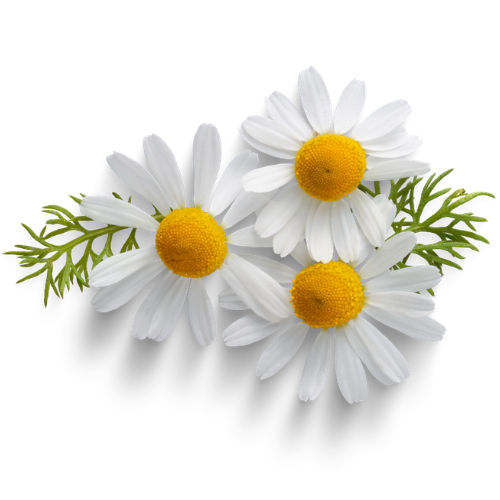
We love it for..
Insomnia, Nervous Tension
It is an excellent herb for many digestive disorders and for nervous tension and irritability. Externally, it is used for sore skin and eczema.
Why We Love It
German chamomile’s aromatic, slightly bitter taste, reminiscent of apples, is familiar to herbal tea drinkers.
■ Premenstrual syndrome
An Iranian clinical trial compared chamomile with mefenamic acid for relief of premenstrual syndrome symptoms. Both were found effective in relieving the physical symptoms of premenstrual syndrome, but chamomile proved better in
relieving emotional symptoms.
■ Digestive problems German chamomile has been taken for digestive problems since at least the 1st century ce. Gentle and efficacious, it is very suitable for children. The herb is valuable for pain, indigestion, acidity, gastritis, gas, bloating, and colic. It is also used for hiatal hernia, peptic ulcer, Crohn’s disease, and irritable
bowel syndrome.
■ Relaxation German chamomile, which contains spiroether, a strong antispasmodic, eases tense muscles and period pain. It is known that women in ancient Rome commonly took chamomile to relieve menstrual cramps. Chamomile flowers also reduce irritability and promote sleep—especially helpful for children. ■ Irritation The herb is useful for hay fever and asthma. On steam distillation, the proazulenes produce chamazulene, which is markedly antiallergenic. Externally, it can be applied to sore, itchy skin, and eczema. It also relieves eyestrain. A poultice can be applied to sore breasts.
Research Studies
| Scientific Name | Chamomilla recutita syn. matricaria recutita (Asteraceae) |
| Description | German chamomile is a sweetly aromatic annual growing to 2 ft (60 cm), with finely cut leaves and white flower heads. |
| Constituents | Volatile oil (proazulenes, farnesine, alpha-bisabolol, spiroether), Flavonoids, Bitter glycosides (anthemic acid), Coumarins |
| Habitat & Cultivation | German chamomile grows in much of Europe and other temperate regions. The seeds are sown in spring or autumn and the flower heads are picked in full bloom, in summer. |
| Parts Used | Flower heads may be used fresh or dried. They should be picked on the day they open, when the active constituents are at their strongest. It contains flower heads contain volatile oil, which has antiallergenic compounds. |
| Key Actions | Anti-inflammatory, Antiallergenic, Antispasmodic, Relaxant, Carminative |
| Cautions | The fresh plant can cause dermatitis. Do not take the essential oil internally except under professional supervision. Take only on professional advice if using blood-thinning medication. Do not use the oil externally during pregnancy. |
Clinical Studies
■ Trials in Germany A cream made from German chamomile
was tested in 1987 for its ability to heal wounds. The results produced were very positive. In 1993, another trial using German chamomile and four other herbs showed them to be most effective at easing infantile colic.
■ Premenstrual syndrome An Iranian clinical trial compared chamomile with mefenamic acid for relief of premenstrual syndrome symptoms. Both were found effective in relieving the physical symptoms of premenstrual syndrome, but chamomile proved better in relieving emotional symptoms.